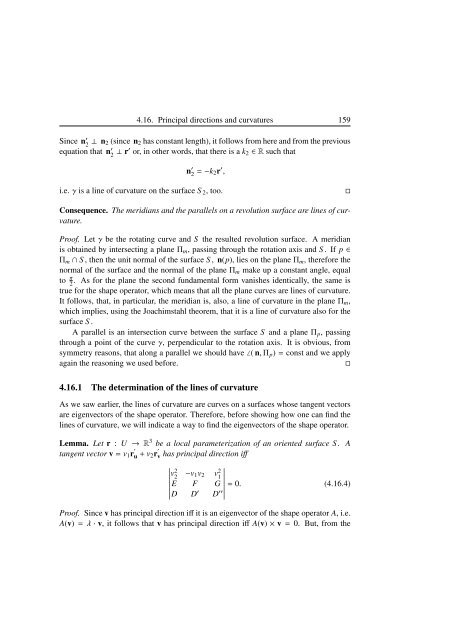Blaga P. Lectures on the differential geometry of - tiera.ru
Blaga P. Lectures on the differential geometry of - tiera.ru
Blaga P. Lectures on the differential geometry of - tiera.ru
You also want an ePaper? Increase the reach of your titles
YUMPU automatically turns print PDFs into web optimized ePapers that Google loves.
4.16. Principal directi<strong>on</strong>s and curvatures 159<br />
Since n ′ 2 ⊥ n2 (since n2 has c<strong>on</strong>stant length), it follows from here and from <strong>the</strong> previous<br />
equati<strong>on</strong> that n ′ 2 ⊥ r′ or, in o<strong>the</strong>r words, that <strong>the</strong>re is a k2 ∈ R such that<br />
n ′ 2 = −k2r ′ ,<br />
i.e. γ is a line <strong>of</strong> curvature <strong>on</strong> <strong>the</strong> surface S 2, too. �<br />
C<strong>on</strong>sequence. The meridians and <strong>the</strong> parallels <strong>on</strong> a revoluti<strong>on</strong> surface are lines <strong>of</strong> curvature.<br />
Pro<strong>of</strong>. Let γ be <strong>the</strong> rotating curve and S <strong>the</strong> resulted revoluti<strong>on</strong> surface. A meridian<br />
is obtained by intersecting a plane Πm, passing through <strong>the</strong> rotati<strong>on</strong> axis and S . If p ∈<br />
Πm ∩ S , <strong>the</strong>n <strong>the</strong> unit normal <strong>of</strong> <strong>the</strong> surface S , n(p), lies <strong>on</strong> <strong>the</strong> plane Πm, <strong>the</strong>refore <strong>the</strong><br />
normal <strong>of</strong> <strong>the</strong> surface and <strong>the</strong> normal <strong>of</strong> <strong>the</strong> plane Πm make up a c<strong>on</strong>stant angle, equal<br />
to π<br />
2 . As for <strong>the</strong> plane <strong>the</strong> sec<strong>on</strong>d fundamental form vanishes identically, <strong>the</strong> same is<br />
t<strong>ru</strong>e for <strong>the</strong> shape operator, which means that all <strong>the</strong> plane curves are lines <strong>of</strong> curvature.<br />
It follows, that, in particular, <strong>the</strong> meridian is, also, a line <strong>of</strong> curvature in <strong>the</strong> plane Πm,<br />
which implies, using <strong>the</strong> Joachimstahl <strong>the</strong>orem, that it is a line <strong>of</strong> curvature also for <strong>the</strong><br />
surface S .<br />
A parallel is an intersecti<strong>on</strong> curve between <strong>the</strong> surface S and a plane Πp, passing<br />
through a point <strong>of</strong> <strong>the</strong> curve γ, perpendicular to <strong>the</strong> rotati<strong>on</strong> axis. It is obvious, from<br />
symmetry reas<strong>on</strong>s, that al<strong>on</strong>g a parallel we should have ∠( n, Πp) = c<strong>on</strong>st and we apply<br />
again <strong>the</strong> reas<strong>on</strong>ing we used before. �<br />
4.16.1 The determinati<strong>on</strong> <strong>of</strong> <strong>the</strong> lines <strong>of</strong> curvature<br />
As we saw earlier, <strong>the</strong> lines <strong>of</strong> curvature are curves <strong>on</strong> a surfaces whose tangent vectors<br />
are eigenvectors <strong>of</strong> <strong>the</strong> shape operator. Therefore, before showing how <strong>on</strong>e can find <strong>the</strong><br />
lines <strong>of</strong> curvature, we will indicate a way to find <strong>the</strong> eigenvectors <strong>of</strong> <strong>the</strong> shape operator.<br />
Lemma. Let r : U → R 3 be a local parameterizati<strong>on</strong> <strong>of</strong> an oriented surface S . A<br />
tangent vector v = v1r ′<br />
u + v2r ′<br />
v has principal directi<strong>on</strong> iff<br />
�<br />
�<br />
�<br />
�v<br />
�<br />
�<br />
�<br />
�<br />
�<br />
2 2 −v1v2 v2 �<br />
�<br />
�<br />
1 �<br />
E F G<br />
�<br />
�<br />
� = 0. (4.16.4)<br />
�<br />
�<br />
D D ′ D ′′<br />
Pro<strong>of</strong>. Since v has principal directi<strong>on</strong> iff it is an eigenvector <strong>of</strong> <strong>the</strong> shape operator A, i.e.<br />
A(v) = λ · v, it follows that v has principal directi<strong>on</strong> iff A(v) × v = 0. But, from <strong>the</strong>












